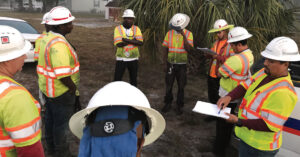10 Essential Safety Tips for Construction Job Site Supervisors
Construction job site supervisors and foremen serve as one of the first lines of defense when it comes to protecting workers and fostering a culture of safety. Supervisors are responsible for not only overseeing daily operations but also ensuring that everyone on site is adhering to safety protocols, using equipment properly and working under conditions that minimize risks.
These roles require a unique blend of leadership, vigilance, communication and technical knowledge. Whether managing a small team or coordinating across multiple crews, the supervisor’s influence is critical in preventing accidents and ensuring the well-being of every craft professional on site.
These 10 essential safety tips are important practices that every construction foreman and supervisor should integrate into their job sites.
1. Conduct Regular Safety Meetings

Safety begins with communication. Regularly scheduled toolbox talks or safety meetings provide opportunities to reinforce safety protocols, discuss current working conditions and potential hazards and address specific risks associated with ongoing activities on site. These meetings should be a forum for open dialogue where safety concerns can be voiced and addressed promptly.
2. Inspect Equipment Daily
Prior to any work commencing, foremen and crews must conduct thorough daily inspections of all equipment and machinery. This includes cranes and heavy equipment, scaffolding, power tools and personal protective equipment (PPE). Ensuring that equipment is in proper working condition reduces the risk of accidents due to preventable failures.
3. Enforce Personal Protective Equipment Use
PPE is a critical line of defense against workplace injuries. Supervisors should enforce the use of appropriate PPE such as helmets and hard hats, gloves, eye protection, hearing protection and high-visibility clothing. It’s equally important to ensure that PPE fits properly for all crew members and is in good condition to provide maximum protection.
4. Monitor Workers’ Health and Well-being
Construction work is physically demanding, especially in adverse weather conditions. Supervisors should monitor workers for signs of fatigue, dehydration or heat stress, particularly during hot weather. Encouraging regular breaks, hydration and maintaining a healthy work-life balance can help prevent health-related incidents on site.
5. Implement Fall Protection Systems
According to OSHA, falls are the leading cause of serious injuries and fatalities in construction. Supervisors must ensure that appropriate fall protection systems such as guardrails, safety nets and personal fall arrest systems are in place and used correctly, especially when working at heights exceeding six feet.
6. Keep the Site Organized and Clean
A cluttered or disorganized work site is not only inefficient but also hazardous. Foremen should make sure their crews maintain clear walkways, properly secure and store materials and promptly remove debris and scraps. Keeping the site organized reduces the risk of trips, slips and falls caused by out-of-place items.
7. Promote Communication Site-Wide
Effective communication is essential in a dynamic construction environment. In addition to discussing important safety matters at daily meetings, Supervisors should also ensure that hazard warnings and safety procedures are clearly communicated to all workers through signage, radios and hand signal (particularly in noisy or busy areas of the site) and in normal conversation.
8. Enforce the Use of Safe Lifting Techniques
Improper lifting techniques can lead to serious back injuries for crew members. Supervisors should train all workers on safe lifting practices and ensure the use of mechanical lifting aids such as cranes or hoists when handling heavy materials. Encouraging teamwork for lifting tasks can also mitigate risks.
9. Ensure Proper Training for All Workers
Competent workers are safer workers. Supervisors must ensure that all personnel are adequately trained for their specific tasks, including handling hazardous materials, operating machinery and tools and using safety and craft-related equipment. Ongoing training should be provided to keep skills current and address new safety challenges.
10. Develop and Follow Emergency Procedures
Construction sites are inherently risky environments where emergencies can occur. Supervisors should develop comprehensive emergency procedures that include evacuation plans, designated muster points and protocols for first aid and emergency response. Regular drills and training sessions ensure that all workers are prepared to respond effectively in crisis situations.
Enhancing Leadership Skills
These tips can help make a construction project safer, but it takes the right kind of leader to implement them properly.
NCCER’s Construction Foreman Certification Program offers invaluable training for supervisors looking to improve their professional skills. This program covers critical areas of field leadership, including important health, safety and communication topics, that equip foremen and supervisors to effectively manage teams and promote a safe and productive culture on site.
By prioritizing these essential safety tips and investing in professional development, construction job site supervisors can play a pivotal role in safeguarding the well-being of their teams and achieving operational excellence.

